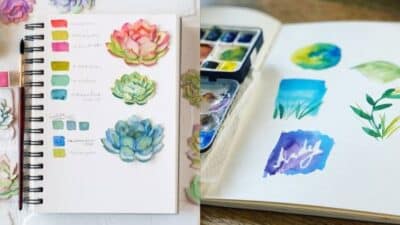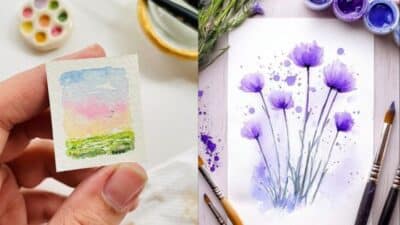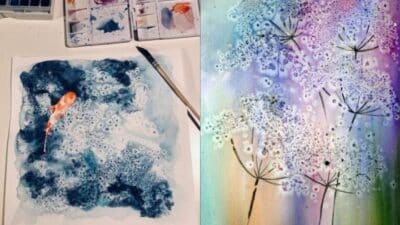Animal watercolor painting offers a unique way to capture the delicate textures and vibrant colors of wildlife with a soft, fluid touch. Whether you’re a beginner or experienced artist, learning to paint animals in watercolor allows you to bring life to your art through careful layering, color mixing, and attention to natural shapes and patterns. Mastering simple techniques like sketching basic animal outlines and understanding how to use watercolor’s transparency can help you create expressive and captivating animal portraits.
You will find that watercolor is especially suited for depicting the softness of fur and feathers, along with the subtle variations in color found in nature. With a variety of subject choices and straightforward methods available, you can gradually develop your skills while enjoying the satisfaction of transforming a blank page into a portrayal of your favorite animals.
Key Takeways
- You can create detailed animal portraits by mastering basic watercolor techniques.
- Understanding how to layer and blend colors enhances the natural look of animals.
- Choosing the right subjects and practicing regularly supports steady artistic growth.
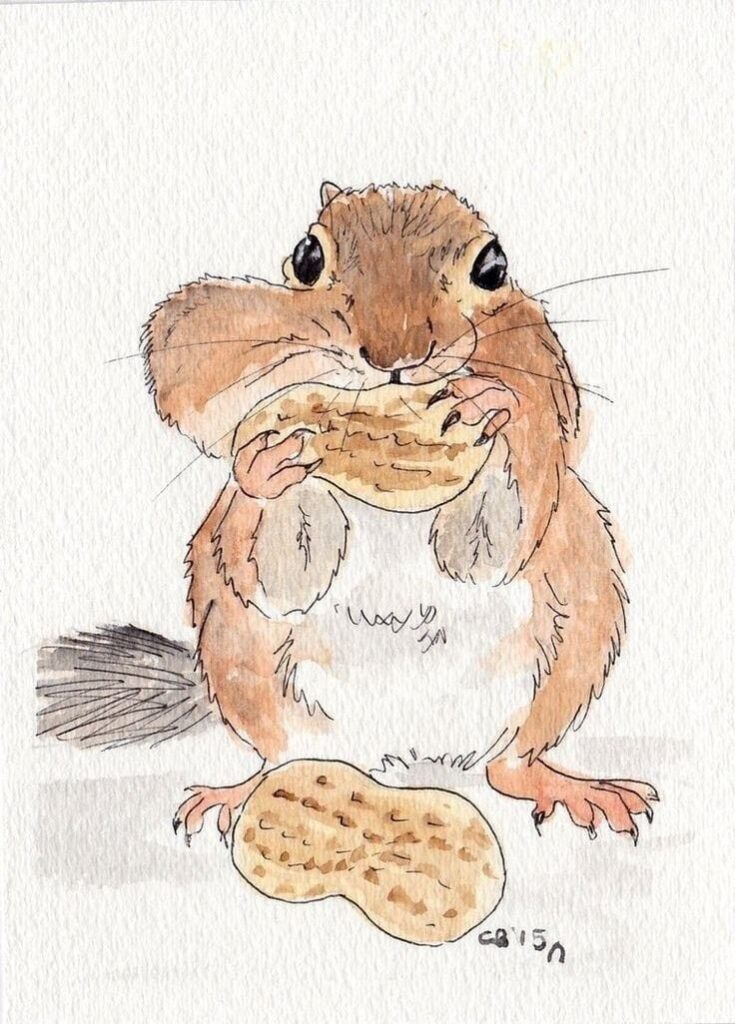
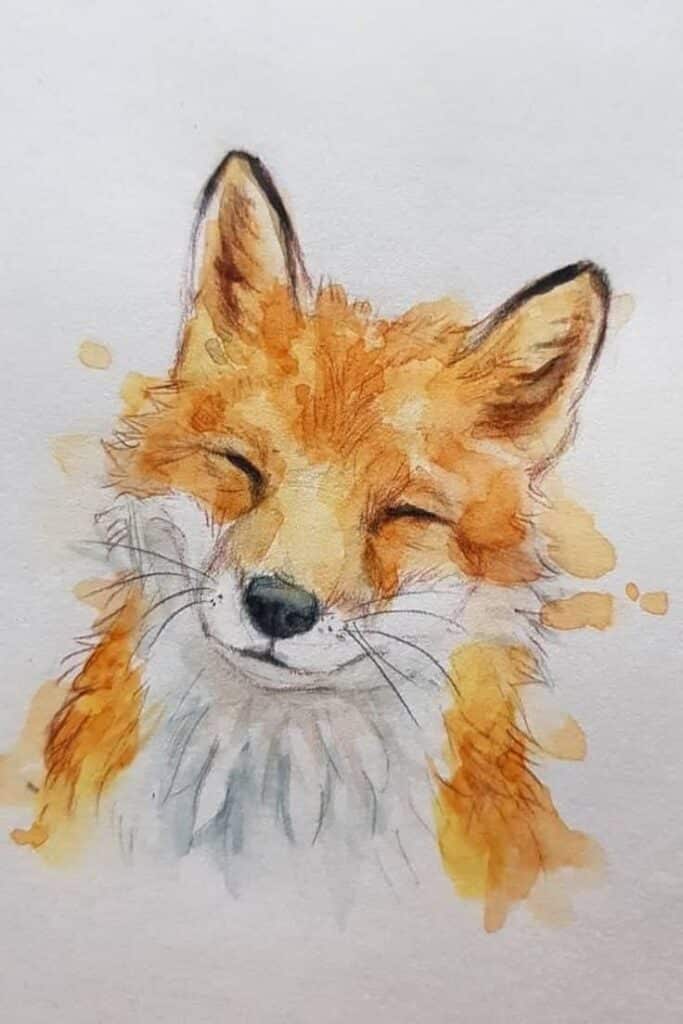
Understanding Animal Watercolor Art
Animal watercolor art combines the delicate and fluid qualities of watercolor painting with detailed depictions of animal forms. It requires attention to anatomy, texture, and color dynamics to create lifelike images that capture the essence of the subject.
Defining Animal Watercolor
Animal watercolor is a specific genre of watercolor painting focused on representing animals realistically or stylistically. You use transparent layers, wet-on-wet washes, and controlled brushwork to convey textures like fur, feathers, and skin.
Precision in anatomy is crucial. Basic shapes guide your structure, while gradients and soft edges simulate natural light and shadow. This medium demands mastery over water control and pigments to balance softness with defined details.
Understanding the animal’s form and movement helps you avoid stiffness in your artwork. You achieve depth by layering washes and allowing pigment granulation, which gives your subjects a natural, organic look often missing in other media.
History and Popularity
Animal watercolor has roots dating back centuries, but it gained prominence in the 18th and 19th centuries through naturalists and illustrators documenting wildlife. These artists prioritized accuracy in anatomy and coloration to educate and inspire.
Today, you encounter this style in both scientific illustration and contemporary art. Its popularity continues to grow among hobbyists and professionals due to watercolor’s accessibility and versatility.
The fluid nature of watercolor suits the depiction of animals’ natural environments, allowing you to blend backgrounds seamlessly. Social media and online tutorials have expanded access, making it easier for you to learn and share animal watercolor skills.
Comparison to Other Art Styles
Compared to oil or acrylic painting, watercolor requires quicker drying and less layering, demanding immediate precision. Your strokes must be deliberate, as revisions are limited once pigment interacts with water.
In contrast to sketching or digital art, watercolor adds unpredictability through its flow and pigment behavior, challenging you to balance control and spontaneity. This unpredictability can enhance realism when capturing animals’ textures.
Unlike detailed pencil drawings, watercolor offers vibrant color gradations that can better simulate fur, feathers, or scales. You can use dry brush or glazing techniques to emphasize texture, making your animal subjects feel more dimensional and lively.


Essential Techniques for Painting Animals in Watercolor
To paint animals effectively with watercolor, focus on controlling color intensity, building texture, and defining key features. These elements work together to bring your subject to life, balancing realism with artistic expression.
Color Mixing and Layering
You need to mix colors carefully to replicate the subtle hues in animal fur, feathers, or skin. Start with a limited palette, combining primary colors to avoid muddy results. Test color mixtures on scrap paper before applying them.
Layering is crucial for depth. Apply light washes first, letting each layer dry completely before adding darker tones. This prevents colors from bleeding and helps you build shadows and highlights gradually.
Use glazing techniques by applying thin, transparent layers to adjust color temperature or tone. Keep your brush wet but not overloaded with paint for smooth, even layers.
Capturing Animal Textures
Texture varies widely—soft fur, rough scales, or sleek feathers require different approaches. Use dry brush strokes to create the appearance of coarse fur or rough skin with uneven, broken lines.
For feathers, employ fine, precise strokes that follow the natural direction of the animal’s plumage. Water control is vital; too much moisture washes out details, while too little can cause harsh edges.
You can also lift paint with a damp brush or tissue to create highlights and textural contrasts. Experiment with spattering or stippling to mimic rough surfaces or fluffy fur effectively.
Detailing Features and Expressions
Animal expressions convey personality and require focused attention on eyes, nose, and mouth. Paint the eyes last, using a small brush and intense pigmentation for sharp reflections and clear pupils.
Avoid overworking details; instead, suggest nuances with subtle gradients and soft edges. Use thin, controlled lines to accentuate whiskers or fine hairs.
Observe your subject carefully to capture unique markings and shapes. Accurate proportions and well-placed highlights, especially around the eyes, can transform your painting from basic to lifelike.


Creating Animal Portraits with Watercolor
To create strong animal portraits in watercolor, you must establish a solid foundation with accurate shapes and anatomy. Capturing the subject’s character and choosing the right animal will also guide your artistic decisions and elevate your final piece.
Drawing Accurate Animal Forms
Begin by studying your animal subject with close attention to anatomy. Focus on basic shapes—circles for heads, ovals for bodies—before refining details. This groundwork helps maintain correct proportions and ensures your painting feels realistic.
Use light pencil lines to sketch the outline. Avoid heavy marks, as watercolor is transparent and mistakes can show through. Pay special attention to features like eyes, ears, and limbs, which define the species and posture.
You may find working from photographs useful for accuracy. Break down complex forms into simple shapes and gradually add details. Accurate drawing sets the stage for believable fur texture, feathers, or scales in watercolor.


Emphasizing Personality in Portraits
To capture animal personality, observe expressions, posture, and subtle details unique to your subject. Eyes often carry emotion, so focus on their shape, reflections, and shadows. This adds depth and connection to your portrait.
Use watercolor techniques like glazing and layering to highlight the animal’s mood or character. Soft washes create gentle atmospheres, while sharper edges can emphasize alertness or curiosity.
Small gestures—like the tilt of a head or relaxed muscles—convey individuality. Pay attention to these nuances during both your sketch and painting. The goal is to move beyond a static image and suggest life through color and form.
Choosing Subjects for Animal Portraits
Select animals with distinct features or a meaningful connection to you. Pets often make compelling subjects because familiarity allows you to notice specific traits.
Consider the complexity of fur patterns, feathers, or scales when choosing. Beginners may want to start with simpler shapes and fewer color variations, such as cats or birds with smooth feathers.
Also, think about the pose and lighting. A well-lit subject in a relaxed pose shows details clearly and enhances your ability to capture realism. Ultimately, choose animals that inspire you and fit your technical skills, ensuring a rewarding watercolor painting experience.


Inspiring Ideas and Subjects for Animal Watercolor
Exploring different animal subjects helps you develop diverse techniques and styles in watercolor painting. Choosing specific animals allows you to focus on unique textures, colors, and shapes that challenge your skills.
Wildlife and Exotic Animals
Painting wildlife introduces you to a variety of textures and colors unique to each species. You can capture the sleek fur of a tiger, the iridescent feathers of a peacock, or the rugged scales of a reptile. These subjects often involve dynamic poses, encouraging you to practice movement and anatomy.
Focus on animals like lions, elephants, or tropical birds to experiment with vibrant colors and strong contrasts. Wildlife subjects are ideal if you want to practice realism and detail. You can also use loose washes to suggest motion or evoke an atmospheric feeling around your subject.
Pets and Domestic Animals
Pets offer familiar shapes and expressions, making them excellent subject choices for both beginners and experienced painters. Dogs, cats, rabbits, and birds are common subjects. They allow you to focus on personality and emotion through subtle changes in color and brushwork.
You can experiment with fur texture or the shine of a pet’s eyes. These subjects give a chance to tell a story or capture moments of everyday life. Domestic animals often stay still longer, making detailed studies easier.
Fantasy and Whimsical Animals
Fantasy animal painting lets you blend imagination with real animal features. You might create creatures like winged horses, colorful dragons, or hybrid animals. This approach encourages freedom in your color palette and form.
Use loose brushstrokes and vibrant colors to evoke whimsy. Fantasy subjects challenge you to invent textures and shapes while applying fundamental watercolor techniques. This category is perfect if you want to move beyond realism and explore creative storytelling.


Showcasing and Sharing Animal Watercolor Art
Presenting your animal watercolor paintings effectively highlights their details and craftsmanship. You can enhance their appeal through smart framing and by engaging with online art communities to expand your reach and receive feedback.
Framing and Displaying Finished Works
Choose acid-free mats and UV-protective glass to preserve your watercolor’s delicate pigments. A mat creates a visual space between the painting and the frame, preventing damage and enhancing focus on the artwork.
Frame colors should complement your painting’s tones—neutral frames work well with both vibrant and muted animal subjects. Consider the surrounding environment; for example, wooden frames suit rustic décor, while sleek black frames fit modern interiors.
Use hanging hardware appropriate for your wall type to securely display your work. Proper lighting, ideally natural or soft LED, reduces glare and shadows without fading colors. Rotate artworks occasionally to avoid uneven light exposure.
Digital Sharing and Online Communities
Photograph your paintings with even lighting and neutral backgrounds to capture true colors. Use image editing tools to adjust brightness or crop, but avoid altering the artwork’s appearance.
Share your work on platforms like Instagram, DeviantArt, or specialized watercolor forums. Use relevant hashtags such as #WatercolorAnimals or #AnimalArt to reach interested viewers.
Engage with communities by commenting on others’ work and participating in art challenges or collaborations. These interactions can provide constructive feedback and help you grow your audience. Regular posting keeps your portfolio visible and builds connections with fellow artists and enthusiasts.
- 209shares
- Facebook0
- Pinterest206
- Twitter3
- Reddit0

